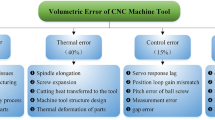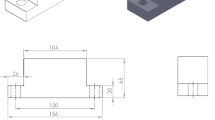Abstract
Spindle speed optimization is important for the machining industry to improve the material removal rate (MRR). However, low spindle speeds are always used to avoid inaccuracy caused by the chatter and forced vibration. Especially for the five-axis flank milling, the selection of spindle speeds is conservative since the complexity of the tool-workpiece engagement (TWE) and the corresponding dynamics. This paper presents a spindle speed optimization method to improve MRR with the consideration of chatter and forced vibration for five-axis flank milling. Chatter and forced vibration models of five-axis flank milling are developed based on the general cutting dynamics model. The root-mean-square (RMS) values of the forced vibration displacement are employed to evaluate the surface quality. The relationship between the stable spindle speed and the forced vibration reveals that the surface quality is positively associated with the spindle speed in some specific ranges, and MRR is improved by increasing the spindle speed in those ranges without the risk of increasing inaccuracy. The simulation results and experimental work show that the proposed method can be used to optimize spindle speeds for improving MRR without inducing chatter and aggressive forced vibration.














Similar content being viewed by others
Data availability
All data generated or analyzed during this study are included in this article.
Reference
Tlusty J, Zaton W, Ismail F (1983) Stability lobes in milling. CIRP Ann - Manuf Technol 32:309–313
Altinta Y, Budak E (1995) Analytical prediction of stability lobes in milling. CIRP Ann 44:357–362
Insperger T, Stépán G (2004) Updated semi-discretization method for periodic delay-differential equations with discrete delay. Int J Numer Meth Engng 61:117–141. https://doi.org/10.1002/nme.1061
Ding Y, Zhu L, Zhang X, Ding H (2010) A full-discretization method for prediction of milling stability. Int J Mach Tools Manuf 50:502–509. https://doi.org/10.1016/j.ijmachtools.2010.01.003
Tlusty J, Polacek M (1963) ) The stability of machine tools against self-excited vibrations in machining, international research in production engineering. Mach Sci Technol 465–474
Tobias SA (1969) Machine tool vibration. Blackie and Sons Ltd
Minis I, Yanushevsky R, Tembo A, Hocken R (1990) Analysis of linear and nonlinear chatter in milling. CIRP Ann 39:459–462. https://doi.org/10.1016/S0007-8506(07)61096-8
Budak E (1994) The mechanics and dynamics of milling of thin-walled structure. Dissertation, University of British Columbia
Altintas Y (1999) Analytical prediction of stability lobes in ball end milling. J Manuf Sci Eng 121:586–592
Altintas Y, Stepan G, Budak E et al (2020) Chatter stability of machining operations. J Manuf Sci Eng 142:1–46
Li W, Wang L, Yu G (2021) Force-induced deformation prediction and flexible error compensation strategy in flank milling of thin-walled parts. J Mater Process Technol 297:117258. https://doi.org/10.1016/j.jmatprotec.2021.117258
Li J, Kilic ZM, Altintas Y (2020) General cutting dynamics model for five-axis ball-end milling operations. J Manuf Sci Eng 142:121003. https://doi.org/10.1115/1.4047625
Altintas Y, Montgomery D, Budak E (1991) Dynamic peripheral milling of flexible structures. J Manuf Sci Eng 13:229. https://doi.org/10.1016/0141-6359(91)90138-9
Budak E, Altintas Y (1995) Modeling and avoidance of static form errors in peripheral milling of plates. Int J Mach Tools Manuf 35:459–476. https://doi.org/10.1016/0890-6955(94)P2628-S
Ratchev S, Liu S, Huang W, Becker AA (2004) Milling error prediction and compensation in machining of low-rigidity parts. Int J Mach Tools Manuf 44:1629–1641. https://doi.org/10.1016/j.ijmachtools.2004.06.001
Seguy S, Dessein G, Arnaud L (2008) Surface roughness variation of thin wall milling, related to modal interactions. Int J Mach Tools Manuf 48:261–274. https://doi.org/10.1016/j.ijmachtools.2007.09.005
Budak E, Tekeli A (2005) Maximizing chatter free material removal rate in milling through optimal selection of axial and radial depth of cut pairs. CIRP Ann 54:353–356. https://doi.org/10.1016/S0007-8506(07)60121-8
Tang A, Liu Z (2009) Three-dimensional stability lobe and maximum material removal rate in end milling of thin-walled plate. Int J Adv Manuf Technol 43:33–39. https://doi.org/10.1007/s00170-008-1695-y
Svoboda A, Tatar K, Norman P, Bäckström M (2008) Integrated approach for prediction of stability limits for machining with large volumes of material removal. Int J Prod Res 46:3207–3222. https://doi.org/10.1080/00207540601100924
Zhang X, Ding H (2013) Note on a novel method for machining parameters optimization in a chatter-free milling process. Int J Mach Tools Manuf 72:11–15. https://doi.org/10.1016/j.ijmachtools.2013.04.006
Ringgaard K, Mohammadi Y, Merrild C et al (2019) Optimization of material removal rate in milling of thin-walled structures using penalty cost function. Int J Mach Tools Manuf 145:103430. https://doi.org/10.1016/j.ijmachtools.2019.103430
Deng C, Feng Y, Miao J et al (2019) Multi-objective machining parameters optimization for chatter-free milling process considering material removal rate and surface location error. IEEE Access 7:183823–183837. https://doi.org/10.1109/ACCESS.2019.2949423
Okokpujie IP, Ohunakin OS, Bolu CA (2021) Multi-objective optimization of machining factors on surface roughness, material removal rate and cutting force on end-milling using MWCNTs nano-lubricant. Prog Addit Manuf 6:155–178. https://doi.org/10.1007/s40964-020-00161-3
Tunc LT, Zatarain M (2019) Stability optimal selection of stock shape and tool axis in finishing of thin-wall parts. CIRP Ann 68:401–404. https://doi.org/10.1016/j.cirp.2019.04.096
Zhang X, Pan T, Ma A, Zhao W (2022) High efficiency orientated milling parameter optimization with tool wear monitoring in roughing operation. Mech Syst and Signal Pr 165:108394. https://doi.org/10.1016/j.ymssp.2021.108394
Zhang X, Zhao Z, Guo Z, Zhao W (2022) Research on machining parameter optimization in finishing milling with multiple constraints. Proc Inst Mech Eng, Part B: J Eng Manuf 236:968–980. https://doi.org/10.1177/09544054211057989
Nguyen VC, Nguyen TD, Tien DH (2021) Cutting parameter optimization in finishing milling of Ti-6Al-4 V titanium alloy under MQL condition using TOPSIS and ANOVA analysis. Eng Technol Appl Sci Res 11:6775–6780. https://doi.org/10.48084/etasr.4015
Yang J, Altintas Y (2013) Generalized kinematics of five-axis serial machines with non-singular tool path generation. Int J Mach Tools Manuf 75:119–132. https://doi.org/10.1016/j.ijmachtools.2013.09.002
Murray RM, Li Z, Sastry SS (1994) A mathematical introduction to robotic manipulation. CRC Press, Boca Raton, FL
Kilic ZM, Altintas Y (2016) Generalized modelling of cutting tool geometries for unified process simulation. Int J Mach Tools Manuf 104:14–25. https://doi.org/10.1016/j.ijmachtools.2016.01.007
Eynian M (2010) Chatter stability of turning and milling with process damping. Dissertation, University of British Columbia
Ferry WB, Altintas Y (2008) Virtual five-axis flank milling of jet engine impellers—part I: mechanics of five-axis flank milling. J Manuf Sci Eng 130:011005. https://doi.org/10.1115/1.2815761
Smith S, Tlusty J (1992) Stabilizing chatter by automatic spindle speed regulation. CIRP Ann 41:433–436. https://doi.org/10.1016/S0007-8506(07)61238-4
Tang Y, Zhang J, Zhang H et al (2022) Generalized equivalent method for dynamics of multipocket thin-walled parts. Int J Adv Manuf Technol 120:2731–2745. https://doi.org/10.1007/s00170-022-08961-3
Funding
This research was funded by the National Key R&D Program of China (No. 2018YFB1701901) and Shaanxi Science Foundation for Distinguished Young Scholars (2019JC08) for Jun Zhang.
Author information
Authors and Affiliations
Contributions
Y. Tang: methodology, data curation, formal analysis, writing-original draft, review and editing. J. Zhang: conceptualization, supervision, funding acquisition, writing-review and editing. H. Tian: validation, writing-review and editing. H. Liu: writing-review and editing. W. Zhao: conceptualization, supervision, writing-review and editing.
Corresponding author
Ethics declarations
Ethics approval
Not applicable.
Consent to participate
Not applicable.
Consent for publication
The authors consent that the work entitled as “Optimization method of spindle speed with the consideration of chatter and forced vibration for five-axis flank milling” for possible publication in International Journal of Advanced Manufacturing Technology.
Competing interests
The authors declare no competing interests.
Additional information
Publisher's note
Springer Nature remains neutral with regard to jurisdictional claims in published maps and institutional affiliations.
The authors certify that this manuscript is original and has not been published in whole or in part nor is it being considered for publication elsewhere.
Rights and permissions
Springer Nature or its licensor (e.g. a society or other partner) holds exclusive rights to this article under a publishing agreement with the author(s) or other rightsholder(s); author self-archiving of the accepted manuscript version of this article is solely governed by the terms of such publishing agreement and applicable law.
About this article
Cite this article
Tang, Y., Zhang, J., Tian, H. et al. Optimization method of spindle speed with the consideration of chatter and forced vibration for five-axis flank milling. Int J Adv Manuf Technol 125, 3159–3169 (2023). https://doi.org/10.1007/s00170-023-10894-4
Received:
Accepted:
Published:
Issue Date:
DOI: https://doi.org/10.1007/s00170-023-10894-4




